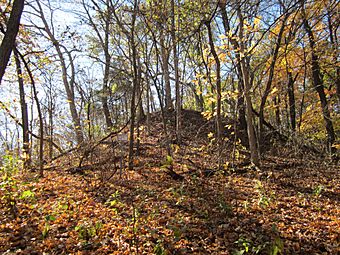Naples Mound 8 facts for kids
Quick facts for kids |
|
|
Naples Mound 8
|
|
 |
|
| Location | Pike County, Illinois |
|---|---|
| Nearest city | Griggsville |
| Area | less than one acre |
| NRHP reference No. | 75000671 |
| Added to NRHP | October 14, 1975 |
The Naples Mound 8 is an ancient burial mound located in Pike County, Illinois. It is about three miles east of the city of Griggsville. This mound was built by the Havana Hopewell culture, an ancient group of people known as mound builders.
The mound was first named Naples Mound #8 in 1882. Later, in 1975, it was added to the National Register of Historic Places. This list includes important historical sites across the United States.
Contents
Discovering the Ancient Mound: The Zelph Story
In 1834, a group of 150 men led by Joseph Smith were traveling through west-central Illinois. On June 3, they found a large burial mound near the Illinois River. This was about three miles east of Griggsville.
Some of the men explored the mound. They found old bones on the surface. When they dug down about a foot, they found a human skeleton. There was a stone arrow point stuck between the ribs. Joseph Smith believed this person was an ancient warrior and leader. He said the warrior was named Zelph. This warrior was thought to have fought in a big battle long ago.
The men carried some of Zelph's bones with them for a while. The arrow point was kept. Six men from the group wrote about finding Zelph Mound in their journals. This event became an important part of their history.
Early Explorations by Local Settlers
After Illinois became a state in 1818, new settlers began to explore the land. They found many ancient burial mounds. Judge John G. Henderson from Winchester, Illinois, was very interested in these mounds. He saw beautiful stone smoking pipes that friends had found in mounds near Naples, Illinois.
In 1876, Judge Henderson and a Mr. Merrill started digging at some of the Naples mounds. They found interesting items like pipes shaped like a raccoon and a turtle. They also found copper axes and human bones. Henderson made a map showing the locations of fifteen mounds near Naples, including Naples Mound #8. He described Naples Mound #8 as a large, oval mound. It was about 150 feet long, 92 feet wide, and 25 to 30 feet high. He also mentioned that an eagle-shaped pipe had been found there about 40 years earlier.
After Henderson wrote about his findings, the Smithsonian Institution became interested. In 1879, they sent workers to help with more excavations. Henderson then wrote an article for the Smithsonian, sharing the results of these important discoveries.
Finding the Mound Again
After 1882, the Naples Mound #8 was mostly forgotten for many years. No one recorded visiting it until 1974. At that time, a new highway bridge was being planned across the Illinois River. This led archaeologists to explore the river bluffs again.
A team of students from Northwestern University, led by Professor Jane E. Buikstra, searched the area. They were mapping ancient burial mounds. They found a very large mound and told a local historian, Warren Winston, about it.
Soon after, a historian named James Bradley, who had been looking for the Zelph Mound for 25 years, visited Warren Winston. They realized that the large mound found by Professor Buikstra's team was the same one known as Zelph Mound. It was identified using old journals and maps.
In 1974, Professor Buikstra renamed the mound Naples-Russell Mound #8 (RN8). The "Russell" part was added because the mound was on land owned by Mr. Roy Russell. In 1975, Buikstra applied to have the mound placed on the National Register of Historic Places. Years later, in 1988, the State of Illinois bought the land, including the mound.
Studying the Mound Scientifically
Archaeologists spent ten years digging in nearby areas for the expressway bridge project. After that, they received permission to dig at Naples-Russell Mound #8. This scientific excavation happened in 1990. It was done by the University of Illinois at Urbana-Champaign, with help from the Center for American Archaeology.
The dig was led by archaeologist Ken Farnsworth. The items found during this excavation confirmed that it was a Hopewell burial mound. It dated back to between 100 B.C. and 500 A.D. These artifacts are now kept at the Illinois State Museum.
The items found in the mound showed that the Hopewell people traded with groups from many different parts of the eastern United States. This shows how far their trade network reached. Pictures of these artifacts have been published recently. Today, the mound is part of the Roy Norbut Fish and Wildlife Area. It is managed by the Illinois Department of Natural Resources.
Images for kids



